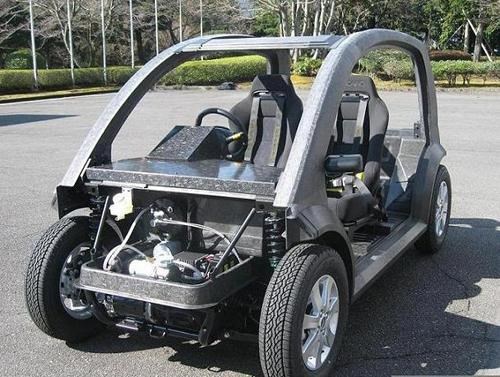Teijin (quietly) announces plans for Sereebo rollout in automotive
Somewhat buried in its Integrated Report 2015, Teijin says the company's thermoplastic-based, high-speed molding process, dubbed Sereebo, is ready for commercialization, necessitating in the process a new Teijin manufacturing facility somewhere in the U.S.

This is the vehicle cell Teijin debuted in 2011 to demonstrate the capabilities of its Sereebo process, which is apparently close to commercialization.
Carbon fiber manufacturer Teijin Ltd. (Tokyo, Japan) has issued its Integrated Report 2015 which, like most annual reports, is full of financial and strategic data designed to give shareholders a sense of what the company's doing, and what it hopes to do.
Somewhat buried in the report, on p. 51 of 117 total, is a short update on the company's efforts to develop it Sereebo process, a system the company is developing with General Motors near Detroit to fabricate carbon fiber-reinforced thermoplastic automotive structures.
Teijin first announced this technology in March 2011, but said very little about it except that it was thermoplastics-based, would offer cycle times of about 60 seconds, and that it would use compression molding. Reports from composites industry professionals we've talked to who have seen the process say that Teijin's fast cycle-time claims are apparently legitimate.
In the just-published annual report, Teijin says: "In carbon fibers, we aim to apply our thermoplastic CFRP Sereebo for use in the structural components of mass-produced automobiles, and have been advancing several development projects through collaboration between the Teijin Composites Innovation Center in Matsuyama, Ehime Prefecture and our Teijin Composites Application Center in Michigan, US. We have entered the final stages of development before commercialization through joint efforts with General Motors. In addition, Teijin has started to examine the construction of a new plant in the U.S." (Emphasis added.)
The report goes on to say, about Sereebo: " In addition to a molding time that is approximately 10 times faster [emphasis added] than that of conventional CFRP, Sereebo contributes to the reduction of CO2 emissions by automobiles — a key concern in both the automobile market and society at large — by reducing vehicle weight, underscoring the outstanding promise of this innovative material. Going forward, we will continue to promote Sereebo’s use in structural components for automobiles, which we see as a significant latent market. We are currently promoting multiple projects targeted at developing specific components for automobiles and establishing mass production procedures."
Two things jump out of these statements. The first is the announcement of a possible new plant in the U.S. It's unclear if Teijin means carbon fiber manufacturing plant, or a facility in which to fabricate automotive parts for automotive use. Either would be a significant strategic expansion for the company, and for the automotive industry. The second statement that jumps out is the reference to Sereebo's cycle time being 10 times faster than that of a conventional carbon fiber composite manufacturing process. Gone, apparently, is the explicit promise of a 60-second cycle time, and the nebulousness of a process "10 times faster" than a conventional process begs the question: What do you consider conventional?
Huntsman's epoxy is used to resin transfer mold parts for the i3BMW , and the quoted cycle time of that material is 5 minutes. BMW will only say that it's less than 10 minutes. So, is Sereebo 10 times faster than a 5-minute cycle, or a 10-minute cycle?
In any case, it is exciting (and a relief) to see Sereebo is moving out of research and development and into production. This could represent a major step in helping move composites even further into automotive structures.
Related Content
Plant tour: Teijin Carbon America Inc., Greenwood, S.C., U.S.
In 2018, Teijin broke ground on a facility that is reportedly the largest capacity carbon fiber line currently in existence. The line has been fully functional for nearly two years and has plenty of room for expansion.
Read MoreInfinite Composites: Type V tanks for space, hydrogen, automotive and more
After a decade of proving its linerless, weight-saving composite tanks with NASA and more than 30 aerospace companies, this CryoSphere pioneer is scaling for growth in commercial space and sustainable transportation on Earth.
Read MoreCombining multifunctional thermoplastic composites, additive manufacturing for next-gen airframe structures
The DOMMINIO project combines AFP with 3D printed gyroid cores, embedded SHM sensors and smart materials for induction-driven disassembly of parts at end of life.
Read MoreBio-based acrylonitrile for carbon fiber manufacture
The quest for a sustainable source of acrylonitrile for carbon fiber manufacture has made the leap from the lab to the market.
Read MoreRead Next
All-recycled, needle-punched nonwoven CFRP slashes carbon footprint of Formula 2 seat
Dallara and Tenowo collaborate to produce a race-ready Formula 2 seat using recycled carbon fiber, reducing CO2 emissions by 97.5% compared to virgin materials.
Read MoreDeveloping bonded composite repair for ships, offshore units
Bureau Veritas and industry partners issue guidelines and pave the way for certification via StrengthBond Offshore project.
Read MorePlant tour: Daher Shap’in TechCenter and composites production plant, Saint-Aignan-de-Grandlieu, France
Co-located R&D and production advance OOA thermosets, thermoplastics, welding, recycling and digital technologies for faster processing and certification of lighter, more sustainable composites.
Read More






















